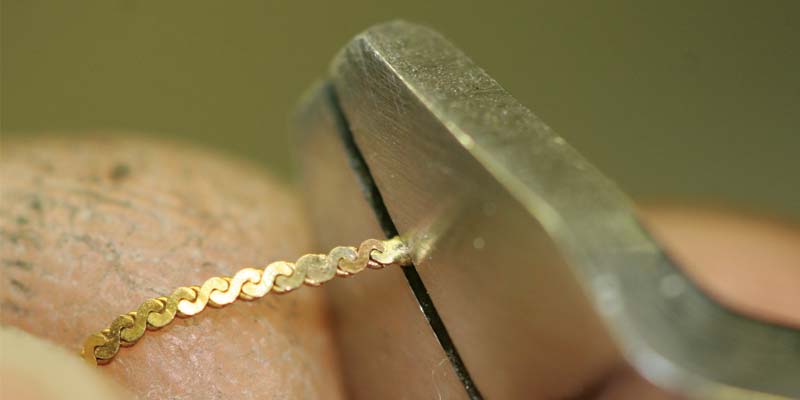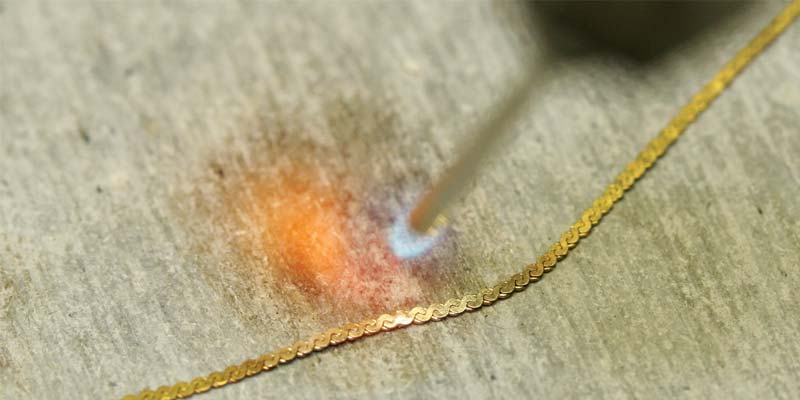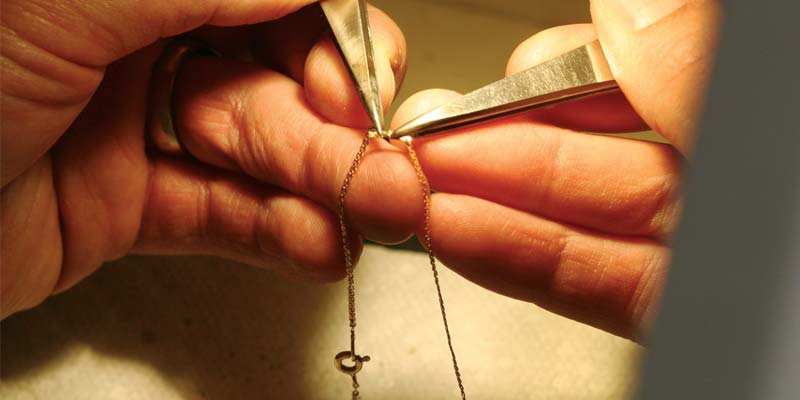Repairing flat chains
For our second example, let’s look at the flat-link serpentine chain in the photo to the left. These types of chains fall in the second category—cobra-link, herringbone, C-link, and box chain are others. All were very popular a few decades ago, but have since taken a back seat to today’s woven and double-link styles. Flat-link chains were nice when worn alone—they looked big, but because the metal was so thin, they didn’t cost much. The problem with these chains, however, is they kink and break easily, especially when worn with a pendant.
Flat-link chains are made of very thin gold stock that melts easily. Therefore, we can use neither higher-temperature hard solders nor can we apply heat directly on the metal. I’ve learned applying a torch’s peripheral heat is the best method of repair. To begin, I heat a section of a soldering pad. Next, I use a pair of tweezers to move the chain with some solder on it into the heat.
After the soldered end cools, I snip through the solder using a pair of flush-end cutters. This eliminates the bulk of the material, leaving just enough to complete the repair. I also prefer to snip directly through the centre of the link. That way, when I match it up to the other end of the chain, the two halves come together and are virtually invisible.
Soldering the two halves of chain back together is also done by applying peripheral heating. I use a flat soldering pad and point the torch’s heat just past the chain links. As the pad becomes hot, the heat’s footprint increases in size. In just a moment, the soldering pad is up to temperature and the soldered ends of the chain flow together. This is the safest method I have found for soldering delicate chains.
Laser welding flat chains
Many of the chains bench jewellers repair every day are stamped out of metal sheets thinner than 0.15 mm. While laser welding the end of a thin chain to a jump ring may be a simple task, creating an invisible laser weld within the body of a broken flat chain can be difficult.
The serpentine chain in the photo to the left proved very difficult to laser weld, even with the laser’s voltage dialed down to approximately 200 volts and the beam’s diameter opened to 20. To complete the task, I used the laser to melt the broken ends. Doing so transformed the thin, layered link into a more solid mass. This is a similar concept to adding solder to the chain ends prior to making the repair. Creating a solid mass allows more heat to be used during the repair. After fusing the tips of the chain, I snipped through the now solid mass to get a flat cut end. Next, I welded the two ends together.
It is clear in the photo to the right that the repair of the laser-welded chain on the left does not look as clean as the thinner soldered chain next to it. While there is a slight visual difference between the two, both repairs only affected a single link, meaning the chains are still very flexible. I’d say that although the soldered chain looks best, both repairs would be considered acceptable.











